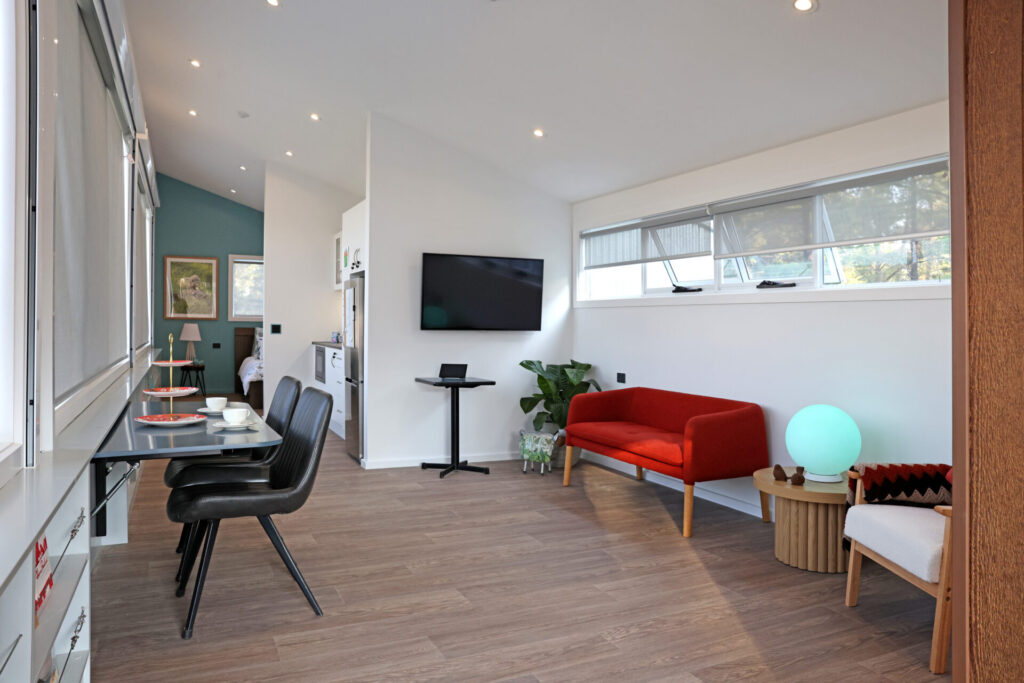A small voluntary community group in rural Victoria has created a world first housing solution for people living with dementia – using technology to guide resident care.
Costerfield House, which opened in Heathcote on World Alzheimer’s Day today, is described by its creators as a transportable and fit-for-purpose Care Villa for people with dementia and their carers.
The ‘Bush Inspired’ innovative architectural design and fit-out created by the Heathcote Dementia Alliance features the latest in artificial intelligence and assistive technology to provide a safe environment for people with dementia to live independently and enjoy quality of life, reducing the challenges and pressures on their carers and families.
Latest statistics estimate there are more than 400,000 Australians living with dementia and more than 1.5 million people in Australia are involved in the care of someone with dementia.
According to Heathcote Dementia Alliance President, Sandra Slatter, as we age with different types of dementia, visual and mental capacity can deteriorate.
“Much thought and planning has gone into the housing design, particularly in the fit-out,” she said.
“For the past four years, we have researched, held community focus groups, taken advice from experts and above all, listened to feedback provided by carers and people living with dementia.
“Funding for Costerfield House has come via donations from local business, community groups and community members. Local community members have also helped with various aspects of the fit-out to help keep costs at a minimum. This is a true example of a community led grass roots initiative,” said Ms Slatter.
Costerfield House is a smart home which provides an opportunity for people with dementia to have quality of life and be supported by their families and the community, she said.
Everything in the home happens at the touch of a button or an instruction to Alexa, Amazon’s voice.

Lighting is automatically controlled by the custom circadian rhythm feature which instinctively matches the natural light of the day and supports wellbeing and the body’s natural rhythm to improve energy levels and sleep patterns. This ceiling light fixture is fitted with a bespoke natural high-quality audio, with a two-way speaker system.
On entering Costerfield House, a swipe of a card opens the door, turns on the lights and TV and the blinds go up. Automated blinds, both block out and sheer, are programmed to automatically close in the evening and open in the morning.
The unique ‘wayfinding’ design uses colour contrast to help someone with dementia find their way through the Care Villa. There is a distinct line of sight from the front door to the main bedroom where the eye is naturally drawn to a coloured feature wall with a large photo of something which relates to the person with dementia, such as their family members or pets.
The Care Villa has camera free sensors fitted to the home. Alert devices, worn by the person with dementia, combined with artificial intelligence and machine learning algorithms, monitor the person’s activities and behaviours in their home environment.
“These sensors discreetly collect data on movement patterns, sleep quality, bathroom usage and meal preparation activities. If the person with dementia has a fall, or the fridge has not been opened by a certain time, a ‘red flag’ alert is sent to a designated family member or an ‘in home’ care provider,” said Ms Slatter.
“While Costerfield House has been specially designed for people living with dementia, the design works for people with a range of conditions who require care and support,” she said.

The vinyl flooring throughout the Villa has been especially chosen because it is water resistant and low maintenance and special slip resistant vinyl flooring has been used in the bathroom.
The kitchen design provides the optimum in functionality, including pull down shelving, lockable drawers, stone benchtop and splashback, induction cooktop, combination grill, microwave and oven, pull out pantry and transparent cupboard doors, enabling residents to easily see what is on shelves, plus a space-saving pull out table for dining.
The main bedroom has been designed with line of sight to the toilet. The wardrobe is another specially designed cabinetry feature, fitted with a pulldown device to enable easy access to clothing for people with accessibility problems. Some doors on the wardrobe are transparent allowing easy visibility of clothing and contents. It is also fitted with LED lighting.
The designer bathroom cleverly masks the accessible shower and toilet. Bathroom features include a heated towel rail and regulated water temperature. Colour is a key feature, with contrasting colour leading into the shower and behind the toilet and the basin to allow for easy identification.
An ’in-home’ care provider’s room has an electronic access door and features a specially designed desk/bed when not in use, with the desk converting to a double bed.
The prototype villa can be viewed at 39 Hospital St, Heathcote (rear Heathcote Health).


